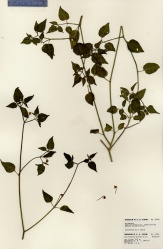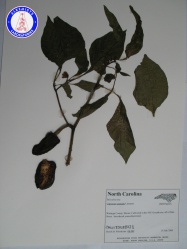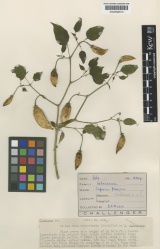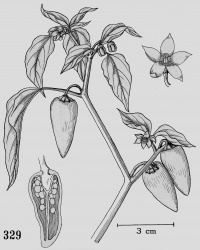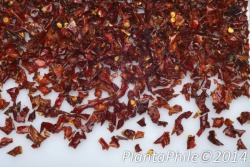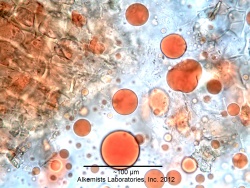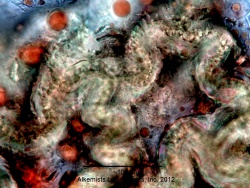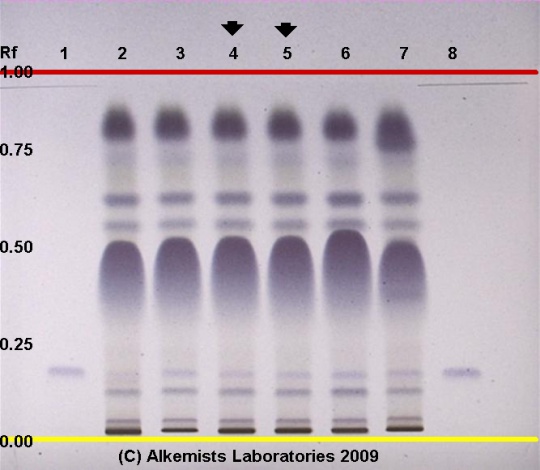Capsicum annuum (fruit)
m |
(add Culbreth ref for organoleptic, macro, micro) |
||
| (5 intermediate revisions by 2 users not shown) | |||
| Line 1: | Line 1: | ||
| − | {{DISPLAYTITLE:''Capsicum annuum'' (fruit) }} | + | {{DISPLAYTITLE:''Capsicum annuum'' (fruit) }} {{askbox|herb=''Capsicum annuum''}} |
=Nomenclature= | =Nomenclature= | ||
| − | |||
{{nomenclature | binomial=Capsicum annuum | {{nomenclature | binomial=Capsicum annuum | ||
|authority=L. var. annuum | |authority=L. var. annuum | ||
| Line 14: | Line 13: | ||
=Botanical Voucher Specimen= | =Botanical Voucher Specimen= | ||
| − | {{ | + | {{Media3 |cat=Voucher | source=MOBOT, Tropicos.org |
| mainimage=Capsicum annuum Tropicos 100018388.jpg | | mainimage=Capsicum annuum Tropicos 100018388.jpg | ||
| companyimage=TropicosLogo.gif | | companyimage=TropicosLogo.gif | ||
| − | | companyURL=http://www.tropicos.org/ | + | | companyURL=http://www.tropicos.org/Image/100018388 |
| − | + | ||
| − | + | ||
| − | + | ||
| description=Cayenne (''Capsicum annuum'') | | description=Cayenne (''Capsicum annuum'') | ||
| − | | reference=Tropicos.org. Missouri Botanical Garden. 13 Sep 2013 <http://www.tropicos.org/Image/100018388> | + | | reference=Tropicos.org. Missouri Botanical Garden. 13 Sep 2013 <http://www.tropicos.org/Image/100018388>. |
| − | | | + | | source2=Botanical Voucher Specimen Library, Alkemists Laboratories |
| + | | image2=Capsicum annuum CAW18508BSI1 A0060.jpg | ||
| + | | companyimage2=AP-LOGO-Laboratories Crop - Copy.jpg | ||
| + | | companyURL2=http://www.alkemist.com | ||
| + | | caption2=''Capsicum annuum'' L. var annuum - Botanical Voucher Specimen - Alkemists Laboratories | ||
| − | + | | companyimage3=Kewlogo.gif | |
| − | + | | companyURL3=http://specimens.kew.org/herbarium/K000592613 | |
| − | + | | image3=Capsicum_annuum_Kew_imageBarcode=K000592613_375476.jpg | |
| − | + | | source3=Royal Botanic Gardens, Kew. | |
| − | + | ||
| − | + | ||
| − | + | ||
| − | + | ||
| − | + | ||
| − | + | ||
| − | |||
| − | |||
| + | }} | ||
| + | =Organoleptic Characteristics= | ||
| + | {| border=1 | ||
| + | | | ||
| + | {{Macroscopy | source=Culbreth, D. (1917) A Manual of Materia Media and Pharmacology, 6th ed. | ||
| + | |description= | ||
| + | | flavor=Intensely pungent. | ||
| + | | scent=Odor characteristic, sternutatory.}} | ||
| + | |} | ||
| + | =Macroscopic Characteristics= | ||
| + | {| border=1 | ||
| + | | | ||
| + | {{Macroscopy | source=Culbreth, D. (1917) A Manual of Materia Media and Pharmacology, 6th ed. | ||
| + | | description='''Plant:''' Small, spreading shrub, .6-1 M. (2-3°) high; stem much branched; leaves alternate 5-7.5 Cm. (2-3') long, entire, glabrous; flowers 2-3 together in the bifurcations, greenish-yellow, July-Aug.; ovary 2-celled, many ovules. | ||
| + | '''Fruit:''' Oblong-conical, 8-20 Mm. (1/3-4/5') long, 2-15 Mm. (1/12-3/5') thick, brownish-red, orange (pericarp), shining, membranous, translucent; 2-3-locular, united below, containing 6-17 flat, reniform, yellowish seeds attached to placenta, frequently detatched. Calyx when present light greenish-brown, inferior, inconspicuous, 5-toothed, usually attached to long straight peduncle. | ||
| + | }} | ||
| + | {{Media3 |cat=Macroscopy | ||
| + | | source=MOBOT, Tropicos.org | ||
| + | | companyimage=TropicosLogo.gif | ||
| + | | companyURL=http://www.tropicos.org/Image/83419 | ||
| + | | mainimage=Capsicum annuum Tropicos 83419.jpg | ||
| + | | caption=''Capsicum annuum'' - Tropicos.org (Manual of Vascular Plants of the Lower Yangtze Valley China Illustration fig. 329 | ||
| + | | reference= Tropicos.org. Missouri Botanical Garden. 13 Sep 2013 <http://www.tropicos.org/Image/83419>. | ||
| + | | source2=PlantaPhile | ||
| + | | image2=PlantaPhile - 3068.jpg | ||
| + | | companyimage2=PlantaPhile logo.jpg | ||
| + | | companyURL2=http://plantaphile.com/ | ||
| + | | image3=Capsicum annuum L. var annuum -Solanaceae- Macro.jpg | ||
| + | | companyURL3=http://www.alkemist.com | ||
| + | | caption3=''Capsicum annuum'' L. var annuum - Botanical Powdered Fruit material - Alkemist Laboratories | ||
| + | | source3=Botanical Voucher Specimen Library, Alkemists Laboratories | ||
| + | | companyimage3=AP-LOGO-Laboratories Crop - Copy.jpg | ||
| + | | )}} | ||
| + | |} | ||
=Microscopic Characteristics= | =Microscopic Characteristics= | ||
| − | {{Microscopy | source=Elan M. Sudberg, Alkemist Laboratories | + | {| border=1 |
| + | | | ||
| + | {{Microscopy | source=Culbreth, D. (1917) A Manual of Materia Media and Pharmacology, 6th ed. | ||
| + | | description=Powder, yellowish-brown; microscopically--mounts with hydrated chloral T. S. (under microscope) show yellowish-red oil globules; stone cells 2 kinds, elongated, uniformly thin-walled (endocarp), irregular, thick-walled (seed-coat). | ||
| + | | adulterants=Fruit: Fruits of allied species; Powder: Red lead oxide, colored sawdust, bran, etc.--the former recognized by adding diluted nitric acid to dissolve lead and precipitating same with sodium sulphate--the two latter by the microscope; corn meal, starch (iodine test), ash 15-18.4 p.c. | ||
| + | }} | ||
| + | |||
| + | {{Media2 |cat=Microscopy| source=Elan M. Sudberg, Alkemist Laboratories | ||
| companyimage=AP-LOGO-Laboratories Crop - Copy.jpg | | companyimage=AP-LOGO-Laboratories Crop - Copy.jpg | ||
| companyURL=http://www.alkemist.com | | companyURL=http://www.alkemist.com | ||
| Line 49: | Line 82: | ||
| caption1=Red oil secretions viewed at 400x with Acidified Chloral Hydrate Soln. | | caption1=Red oil secretions viewed at 400x with Acidified Chloral Hydrate Soln. | ||
| description=Cayenne (fruit) (''Capsicum annuum'' var. ''annuum'' L.) | | description=Cayenne (fruit) (''Capsicum annuum'' var. ''annuum'' L.) | ||
| + | | source2=Elan M. Sudberg, Alkemist Laboratories | ||
| + | | companyimage2=AP-LOGO-Laboratories Crop - Copy.jpg | ||
| + | | companyURL2=http://www.alkemist.com | ||
| + | |||
| image2=Capsicum_annuum_L._var_annuum_-Solanaceae-_yellow_cells_of_testa_epidermis.jpg | | image2=Capsicum_annuum_L._var_annuum_-Solanaceae-_yellow_cells_of_testa_epidermis.jpg | ||
| caption2=Large yellow cells of the testa epidermis with wavy, strongly thickened and pitted radial inner walls viewed at 400x with Acidified Chloral Hydrate Soln. | | caption2=Large yellow cells of the testa epidermis with wavy, strongly thickened and pitted radial inner walls viewed at 400x with Acidified Chloral Hydrate Soln. | ||
| reference=British Pharmacopoeia, 2011 | | reference=British Pharmacopoeia, 2011 | ||
| }} | | }} | ||
| − | + | |} | |
=High Performance Thin Layer Chromatographic Identification= | =High Performance Thin Layer Chromatographic Identification= | ||
{{HPTLC | source=Elan M. Sudberg, Alkemist Laboratories | {{HPTLC | source=Elan M. Sudberg, Alkemist Laboratories | ||
| Line 79: | Line 116: | ||
| reference=British Herbal Pharmacopoeia, 1996 | | reference=British Herbal Pharmacopoeia, 1996 | ||
| }} | | }} | ||
| + | |||
{{HPTLC | source=HPTLC Association | {{HPTLC | source=HPTLC Association | ||
Latest revision as of 20:08, 2 June 2015
Contents |
Nomenclature
Capsicum annuum L. var. annuum Solanaceae
Syn. Capsicum frutescens L.
Standardized common name (English): cayenne
Botanical Voucher Specimen
 |
 |
|
|
|
|
|
Organoleptic Characteristics
|
Macroscopic Characteristics
|
Microscopic Characteristics
|
High Performance Thin Layer Chromatographic Identification
|
Cayenne (fruit) (Capsicum annuum var. annuum L.) Lane Assignments Lanes, from left to right (Track, Volume, Sample):
Reference materials used here have been authenticated by macroscopic, microscopic &/or TLC studies according to the reference source cited below held at Alkemists Laboratories, Costa Mesa, CA. Stationary Phase Silica gel 60, F254, 10 x 10 cm HPTLC plates Mobile Phase toluene: ethyl acetate [7/3] Sample Preparation Method 0.5g+5ml dichloromethane, sncte/cntrfge/dcnt, evap dry (N2), qs 1.0 ml Toluene Detection Method Vanillin/H2SO4 Reagent -> 110° C 5 min -> Visible light Reference see British Herbal Pharmacopoeia, 1996
|
|
Cayenne pepper (fruit) (Capsicum annum / Capsicum frutescens) Lane Assignments Lanes, from left to right (Track, Volume, Sample):
Reference Sample(s) Reference: Dissolve 2 mg of capsaicin in 5 mL of methanol. Dissolve 2 mg of dihydrocapsaicin in 5 mL of methanol. Stationary Phase Stationary phase, i.e. Silica gel 60, RP-18, F254 Mobile Phase Water, methanol 20:80 (v/v) Sample Preparation Method Sample: Mix 1 g of powdered sample with 10 mL of methanol and sonicate for 10 minutes, then centrifuge or filter the solutions and use the supernatants / filtrates as test solutions. Derivatization reagent: Dichloroquinone chlorimide reagent Preparation: 50 mg dichloroquinone chlorimide in 200 mL of ethyl acetate Use: Dip (time 0, speed 5), dry with cold air for 5 min, then expose to ammonia vapor Detection Method Saturated chamber; developing distance 70 mm from lower edge; relative humidity 33% Other Notes Images presented in this entry are examples and are not intended to be used as basis for setting specifications for quality control purposes. System suitability test: Capsaicin: blue zone at Rf ~ 0.47; Dihydrocapsaicin: blue zone at Rf ~ 0.40 Identification: Compare result with reference images. The fingerprint of the test solution is similar to that of the corresponding botanical reference sample. Additional weak zones may be present. The chromatogram of the test solution shows two blue zones at Rf ~ 0.40 and Rf ~ 0.47.
|
Supplementary Information
Sources
- ↑ MOBOT, Tropicos.org http://www.tropicos.org/Image/100018388
- ↑ Botanical Voucher Specimen Library, Alkemists Laboratories http://www.alkemist.com
- ↑ Royal Botanic Gardens, Kew. http://specimens.kew.org/herbarium/K000592613
- ↑ Culbreth, D. (1917) A Manual of Materia Media and Pharmacology, 6th ed.
- ↑ Culbreth, D. (1917) A Manual of Materia Media and Pharmacology, 6th ed.
- ↑ MOBOT, Tropicos.org http://www.tropicos.org/Image/83419
- ↑ PlantaPhile http://plantaphile.com/
- ↑ Botanical Voucher Specimen Library, Alkemists Laboratories http://www.alkemist.com
- ↑ Culbreth, D. (1917) A Manual of Materia Media and Pharmacology, 6th ed.
- ↑ Elan M. Sudberg, Alkemist Laboratories http://www.alkemist.com
- ↑ Elan M. Sudberg, Alkemist Laboratories http://www.alkemist.com
- ↑ Elan M. Sudberg, Alkemist Laboratories http://www.alkemist.com
- ↑ HPTLC Association http://www.hptlc-association.org/
